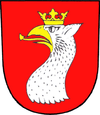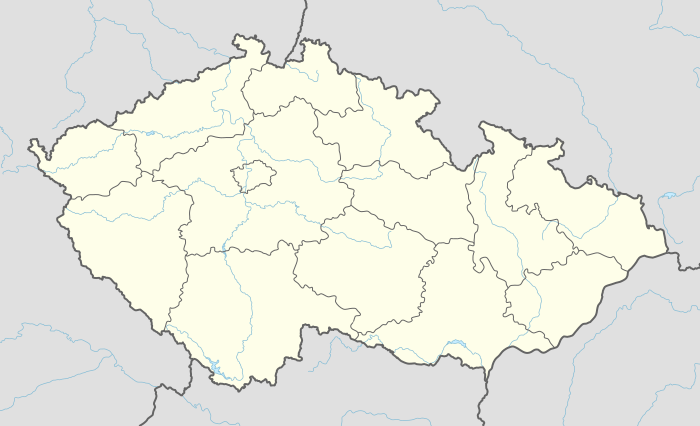Osečná
Osečná (Czech pronunciation: [ˈosɛtʃnaː]; German: Oschitz)is a town in the Liberec District of the Liberec Region in the Czech Republic. Osečná lies on the Ploučnice River, which begins here. The river is 106 km long and flows into the Elbe at Děčín. It has 1075 inhabitants. It lies 15 kilometres from Liberec, on the foot of Ještěd. The town has a primary school, kindergarten, post office, several shops, hospital, and one of the oldest spas in Bohemia, Lázně Kundratice, which was founded in 1881. The moor is used here as a natural resource.
Osečná Oschitz | |
|---|---|
Town | |
.jpg) Town square with Marian column and St Vitus church | |
 Flag  Coat of arms | |
 Osečná Location in the Czech Republic | |
| Coordinates: 50°41′N 14°55′E | |
| Country | Bohemia |
| State | Czech Republic |
| Region | Liberec |
| District | Liberec |
| Municipality | Český Dub |
| First mentioned | 1352 |
| Government | |
| • Mayor | Jiří Hauzer |
| Area | |
| • Total | 28.06 km2 (10.83 sq mi) |
| Elevation | 374 m (1,227 ft) |
| Population | |
| • Total | 1,075 |
| • Density | 38/km2 (99/sq mi) |
| Time zone | UTC+1 (CET) |
| • Summer (DST) | UTC+2 (CEST) |
| Postal code | 463 52 |
| Website | www.osecna.info |
History
Osečná appears to have been founded in the middle of the 13th century, along the trade route which led from the town of Český Dub to the Děvín castle. The name of the town might originate from the word “truncate”, which people had to do before they could build the town – truncate the forest. The founders of Osečná were probably Vartenbergs. In 1234, Osečná became property of the king Ottokar II., then after his death, his son, Wenceslaus II., inherited his property. In 1306, Osečná returned to the Vartenbergs.
In 1516, the Biebersteins bought Osečná and Děvín Castle. On April 8, 1563, Charles the Bieberstein laid the foundation stone for the construction of a new, stone church. Construction took three years. In 1548, the chronicle city was developed. At the end of the 16th century, Charles the Bieberstein sold Osečná and the other villages to Jan Oprsstof. The year 1576 was very important, when emperor Rudolf II. elevated Osečná to a town and it got the law to use an urban character and the seal. The griffin with the golden crown and with the golden armor on the red background is on the Osečná’s urban character. On the bottom was a phrase, “Sigilium oppidi ossensis 1576“.
Osečná had the right to brew beer too and could perform executions until 1769. The executions were held on the hill, which was called “the Gallows hill. Today, the monument of Friedrich Schiller is located here and the name is “Schiller’s Height." Zikmund Smiřický, who bought Osečná in 1591, donated the brewery to the town in 1598 so that Osečná could brew its own beer.
In 1618, Albrecht Jan Smiřický protested against Emperor Ferdinand II., and this had serious consequences. After the Battle of White Mountain, Albrecht von Wallenstein, who had the Duchy of Frýdlant, got this property. The inhabitants of Osečná had to accept Catholicism and they had to pay for a parson from Český Dub too, but they refused. In 1653, the people from Osečná announced the recatholisation, what means they converted back to the Roman Catholic faith.
In 1634, when Albrecht von Wallenstein was killed, his property reverted to Emperor Ferdinand II., who bequeathed it to General Jan Ludvík Hektor in recognition of his military service. When he died, his daughter Regina inherited his property, and she went to Vienna's Saint Jacob Convent in 1643, where she became Mother Superior, and donated her manor to this monastery. Therefore, Osečná belonged for the next 130 years to this convent in Wien. On November 5, 1643, the Swedish army arrived to the Osečná and it destroyed much of the town. They destroyed the town hall, robbed the church, and burned the brewery. It never been restored. A new town hall was opened in the middle of square in 1704.
Osečná suffered many fires during its history. The largest fire broke in the town on June 11, 1825 when almost the entire city burnt. 25 houses, town hall and the tower of church succumbed to the fire, and five bells in the tower completely melted. Nowadays, two bells are located here. This fire was significant: if the town couldn’t burn down then, it could be larger than Liberec.
On August 6, 1838, a Duke from Sychrov Kamil Rohan bought Manor of Český Dub. In 1870, he had the family blazon installed above the entryway to the church, which is still on the same place. On this blazon is written one of the main mottos of the Rohans: “Potius mori quam foedar”, what means: “Is better to die than to betray”.
On October 10, 2006, the town status was returned to Osečná.
A lookout is now under construction in Osečná. It will be 25 metres high and stand on Jiránek’s hill upon the Jeníškovský pond, the source of the Ploučnice River.
Places of interest
- St. Vitus Church
- Plague Column
- Monument of Friedrich Schiller, German writer and poet
- Statue of the Three Saints (St. John, St. Luitgard, St. Paul)
- Devil’s rock – the remains of the basalt vein from tertiary, the devil built it according to legend, national natural monument
- Millennia’s linden in Kotel – height 25 m and the trunk circuit 9, 25 m, the most massive tree in the Liberec region
- Waterfall on the Ploučnice River
- Spring of the Ploučnice River
- Lázně Kundratice – one of the oldest spas in Bohemia